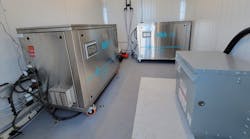Two Georgia wastewater treatment plants have traded in their centrifuges for more efficient models, and in the process saved $300,000 per year in biosolids disposal costs.
Gwinnett County Public Utilities Water Reclamation Division operates two water reclamation facilities that in 1997 upgraded to Sharples? DSX-706 centrifuges. Gwinnett County is a rapidly growing area just northeast of Atlanta, Ga. The region is home to about 525,000 residents, and each year adds another 18,000-20,000.
?This year, we issued 7,100 single-family water connection permits,? said Bob Sheldon, Director of Water Reclamation for Gwinnett County Public Utilities.
?The county operates eight water reclamation facilities, in sizes of 1/2 mgd to 16 mgd,? Sheldon said. ?Crooked Creek is 16 mgd, and Yellow River is 12 mgd.?
Crooked Creek
The Crooked Creek Water Reclamation Facility was constructed in 1987 with a capacity of 6.5 mgd. The facility was expanded in 1990 to 16 mgd, and is currently operating at 12 mgd. The plant is a conventional activated sludge plant with nitrification and phosphorus removal with alum.
When originally built, Crooked Creek had four belt filter presses, delivering a cake dryness of 18 percent. In 1990, in an effort to increase cake dryness and improve overall performance and efficiency, an Alfa Laval Sharples® PM-76000 centrifuge was moved to this plant from the Yellow River Facility.
The PM-76000 is a decanter centrifuge with a maximum bowl speed of 2,600 rpm. It has an 8.5-inch single lead conveyor with sintered Tungsten carbide wear protection tiles, 360-degree solids discharge port with wear liners, and a 198 hp/132 kw main drive motor. The centrifuge operated at a flow rate of 200 gpm on feed solids averaging 2.4 percent attained 20 percent cake dryness at 14 lbs. per ton of polymer.
In 1997 a DSX-706 was installed at the facility. The MaxiMizer DSX line of dry solids centrifuges are designed to have a 30 percent greater throughput and use 20 percent less polymer than competitive centrifuges. The performance requirements for the DSX-706 were cake solids of 23 percent and a polymer dosage of 15 lbs. per ton. Operating at 200 gpm on the feed with 2.4 percent solids, the DSX-706 has achieved 25 percent cake solids.
Gwinnett County officials recognized the potential benefits of drier cake were significant. The plant produces approximately 5,800 dry tons of solids per year. This translates to 29,000 wet tons per year at 20 percent cake dryness and 23,200 wet tons at 25 percent. Thus, with disposal costs currently at $32 per ton, the annual savings in disposal costs is slightly over $185,000 per year.
Yellow River/Sweetwater
The Yellow River/Sweetwater Water Reclamation Facility was constructed in 1981 with a capacity of 6 mgd. The facility was expanded in 1987 to 12 mgd, and currently is operating at 10 mgd. The plant is a conventional activated sludge plant with nitrification, denitrification and phosphorus removal with alum. The influent to the plant averages 97 percent domestic.
In the initial expansion in 1987, three Alfa Laval Sharples? PM-76000s were installed. As noted, one of those units was transferred to Crooked Creek in 1990. The PM-76000s at Yellow River operated at a flow rate of 200 gpm on a feed that ranges from 2.2 to 2.4 percent solids. The PM-76000s attained 21 percent cake dryness using 15 pounds per ton of polymer.
In 1997, a DSX-706 was installed at the facility. The performance requirements for the DSX-706 were cake solids of 23 percent and a polymer dosage of 15 pounds per ton. Operating at 200 gpm, the DSX-706 has achieved 26.5 to 27 percent cake solids.
The plant produces approximately 3,800 dry tons of solids per year. This translates to 18,095 wet tons per year at 21 percent cake dryness and 14,340 wet tons at 26.5 percent. Thus, the DSX-706 is producing an annual disposal savings of over $120,000 per year.
Summary
Installing the two centrifuges took about nine months, most of which was spent getting the equipment on site and ready for installation. ?It was really a pretty straightforward project,? Sheldon said.
In Yellow Rivers case, the DSX unit replaced a machine that was similar in shape and size, and the building was already there. Crooked Creek took a little more work just because the building was originally set up and laid out for a belt press rather than a centrifuge.
Future plans for biosolids include a Class A biosolids facility. The county currently is building a new wastewater treatment facility, called the North Advanced Water Reclamation Facility. The 20 mgd facility will use high lime treatment, which helps to disinfect. It also will have sand filters, activated carbon and ozone disinfection. The district is planning to use egg-shaped digesters and dewatering centrifuges for treatment of biosolids.
?Were also doing a 1 million-gallon demonstration facility on membranes to help us determine the feasibility of using membrane treatment in lieu of high lime treatment,? Shel-don said.
The plan is ultimately to take the plant up to a capacity of 60 mgd, and to release the highly processed water back into a lake from which potable water is drawn. The county plans to generate a Class A biosolids product.

